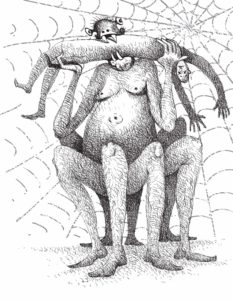
Trickster figures and deities appear in many religions around the world, achieving their desired ends with cunning, playful pranks or outright deceit. You might instantly think of the Norse deity Loki or Raven, the mischievous sun-stealing corvid in mythoi from the Haida and other Pacific Northwest Indigenous tribes. Yet one West African trickster spider, Anansi, is known for his blend of wisdom, sly wit and perhaps inspiring resistance in marginalized black people in the Americas.
A Wise, Cunning Figure in Akan Mythology
Anansi prominently features in the legends of several Akan civilizations in West Africa. Passed down mostly through oral tradition, Anansi’s stories still live on today in Ghana, the Ivory Coast and other parts of western Africa. His name means “spider” in Akan and he is depicted in several different arachnid-like forms. The tales usually describe him as either a man shapeshifting into a spider, an arachnid with a man’s face, a spider wearing human clothes or a human with eight legs.
Some authors and scholars have attempted to collect as many Anansi tales as possible and preserve them in written form. One of these explains how he convinces his father, the Sky God Nyame, to release all the stories hoarded by the great deity. In return, Anansi must bring back Onini the Python, Osebo the Leopard, and the Mboro Hornets. The spider god successfully dupes his targets by doing the following:
- Faking a rainstorm and causing the Hornets to fly into a pot
- Convincing Python to be tied to a branch to measure his length
- Trapping Leopard in a hole and offering a sticky branch to help him climb out
Some versions credit Anansi’s wife, Aso, with helping him devise these clever traps. Many more West African Anansi tales exist, such as how one of his sons tricked him into releasing wisdom into the world by accidentally breaking the pot in which he stored it.
Anansi Tales Take Root in the Americas
The history of the transatlantic slave trade is replete with horrific cruelty, both in physical form and practices intended to erase the slaves’ original African cultures and traditions. Despite these efforts, stories of Anansi survived with West Africans throughout the Caribbean. The Jamaican versions are probably the most well-known and are still told even in modern times. Ethnographer Martha Warren Beckwith published a collection of these, “Jamaica Anansi Stories,” and a free copy is available from the Internet Sacred Texts Archive.
Even as the tales lived on in North America and the Caribbean, they underwent significant transformations. The New World Encyclopedia cites historian Henry Louis Gates, Jr., whose 1988 book “The Signifying Monkey: A Theory of African-American Literary Criticism” discusses the titular character who outsmarts his nemesis Lion with encoded figurative speech that Lion interprets literally. Gates also mentions Brer Rabbit, who relies on his wits to outsmart antagonists and solve problems. He and other scholars insist that there are similarities between the Signifying Monkey, Brer Rabbit and deities such as Anansi or the Hare from central and south African Bantu tales. In fact, some Jamaican Anansi stories, like his encounter with a “tar baby,” may have been reimaged in the Brer Rabbit narratives.
The Trickster Spider Lives On
Anansi combined wisdom and cleverness to achieve mostly good outcomes in the original Akan myths. Writers like Neil Gaiman have given him new life, working his same wiles as Mr. Nancy in the “American Gods” series. In one scene, Mr. Nancy prompts a group of shackled Africans to burn down the slave ship in which they’re being held. Just like Gaiman’s spider god touching land in America from a plank of the destroyed ship, this figure resurfaces in the New World, providing the inspiration to remain indomitable and overcome in the face of oppression.

